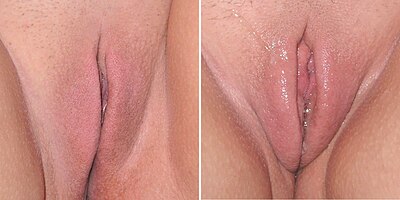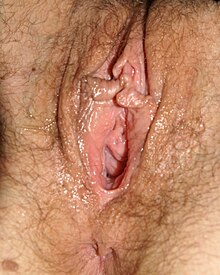Lubrication

As vaginal lubrication ( Latin lubricare , slippery make ' ), the outlet of slimy liquid lubricant, the vaginal secretion from the Bartholin and Skeneschen glands called the woman. The equivalent in men is the pre-ejaculate emerging from the front of the penis during sexual arousal . The lubrication occurs through sexual arousal . It moisturizes the vulva and clitoris and makes it easier for the penis to penetrate during sexual intercourse . Furthermore, the varying levels of pheromones in the vaginal secretion can have a direct influence on sexual attractiveness . If the production of this vaginal fluid is too low, one speaks of a lack of lubrication .
composition
The liquid consists of around 50 different substances that have been proven so far, mainly water , cholesterol , squalene , various fatty acids such as stearic acid , palmitic acid , glycerine , urea , acetic acid and lactic acid , complex alcohols , ketones and aldehydes . It is usually clear and is more reminiscent of male pre-ejaculate than ejaculate . The secretion can vary in consistency, color , smell and taste , depending on the degree of sexual arousal, the point in time in the monthly cycle and diet .
Female primates and females produce copulins . Copulins are pheromones of primates , ie fragrances that on the sense of smell affect males. Biochemically, it is mixtures of volatile, short-chain fatty acids that occur in female vaginal secretions depending on the cycle . Copulins were first described by Richard Michael and colleagues in the late 1960s and early 1970s in rhesus monkeys , for which the sense of smell is very important when mating. Rhesus monkey copulins are mixtures of C 2 -C 6 chain fatty acid molecules such as acetic acid, propionic acid , isobutyric acid , butyric acid , isovaleric acid - and also isocaproic acid - derivatives . Human vaginal secretions are very similar to those of other primates and contain the same volatile fatty acids, but in different compositions. The proportion of the individual fatty acids in vaginal secretions varies over the course of a sexual cycle or menstrual cycle .
In addition, the production rate varies greatly between individuals. For example, some women only produce small amounts of these copulins, and hormonal contraceptives also seem to have a reducing effect on the secretion of copulins. The highest concentration is reached shortly after ovulation .
In men physiological changes and behavioral differences were to Kopulinexposition observed. An increase in testosterone and cortisol levels in saliva has been reported . They rate the sexual attractiveness of themselves and women's faces higher than the control group. And their willingness to cooperate with other men decreases.
Physiology of the vaginal secretion
When a woman experiences sexual arousal, the walls of the vagina begin to swell and secrete a clear fluid (modified plasma transudate ) through hundreds of small ducts in the vaginal tissue. This fluid can first be found inside the vagina, when further arousal it begins to flow through the opening between the labia minora . On the labia minora or on the level of the vaginal vestibule , the Bartholin's glands are also located as additional accessory sex glands , which also produce secretions that additionally moisturize.

The release of these fluids makes sexual foreplay involving the vulva and vagina enjoyable. When enough fluid is formed so that it can also spread over the clitoris , the sexual arousal increases and there is a positive feedback , which in turn increases the secretion from the glands. In the state of highest excitement, some women secrete copious amounts of secretion, others only small amounts. Applying an artificial lubricant to the clitoris can trigger the same positive feedback and thus increase the natural lubrication. If the lubrication in the vaginal entrance is still too low, the lubricant applied here can enable painless vaginal penetration.
As recent research has confirmed, secretion of vaginal secretions can occur even without sexual arousal in the strict sense of the word with regard to a potential sexual partner.
The main part is accounted for by the accessory sex glands of women, especially the Bartholin glands. The vaginal skin also secretes a clear fluid. This fluid is pressed out of the vascular network surrounding the vagina ( transudation ). The greater the excitement, the better this network is supplied with blood and the more fluid can moisten the vagina.
Insufficient lubrication of the vagina can lead to the penetration of the penis during vaginal intercourse being perceived as uncomfortable or even painful. In general, the lubrication decreases with age. During the menopause (the "menopause") and afterwards, a significant decrease in lubrication can be observed in many women .
See also
Web links
Individual evidence
- ^ GR Huggins, G. Preti: Vaginal odors and secretions. In: Clinical obstetrics and gynecology. June 1981, No. 24, Vol. 2, pp. 355-377, PMID 7030563 , ( abstract ).
- ↑ Hans-Rudolf Tinneberg, Michael Kirschbaum, F. Oehmke (eds.): Gießener Gynäkologische Furtherbildung 2003: 23rd further training course for doctors in gynecology and obstetrics. Springer-Verlag, Berlin / Heidelberg / New York 2013, ISBN 3-662-07492-3 , p. 151.
- ^ RP Michael, EB Keverne: Pheromones in the communication of sexual status in primates. In: Nature. No. 218, 1968, pp. 746-749.
- ^ A b R. P. Michael, EB Keverne, RW Bonsall: Pheromones: isolation of male sex attractants from a female primate. In: Science. No. 172, 1971, pp. 964-966, PMID 4995585 .
- ↑ RF Curtis, JA Ballantine, EB Keverne et al: Identification of primate sexual pheromones and the properties of synthetic attractants. In: Nature. No. 232, 1971, pp. 396-398.
- ^ Megan N. Williams, Amy Jacobson, Effect of Copulins on Rating of Female Attractiveness, Mate-Guarding, and Self-Perceived Sexual Desirability. In: Evolutionary Psychology. Volume 14, Number 2, 2016, pp. 1-8, doi: 10.1177 / 1474704916643328
- ↑ K. Grammer, A. Jütte: The war of fragrances: Importance of pheromones for human reproduction. In: Gynecological Obstetric Rundschschau. Volume 37, 1997 pp. 149-153, online
- ↑ AL Cerda-Molina, L. Hernández-López, CE de la O, R. Chavira-Ramírez, R. Mondragón-Ceballos: Changes in Men's Salivary Testosterone and Cortisol Levels, and in Sexual Desire after Smelling Female Axillary and Vulvar Scents. In: Frontiers in endocrinology. Volume 4, 2013, p. 159, doi: 10.3389 / fendo.2013.00159 , PMID 24194730 , PMC 3809382 (free full text).
- ↑ Heike Faller: Sexual Research - Project Pink Viagra . In: ZEITmagazin. No. 31/2009 On: zeit.de - Health, updated on July 23, 2009; last accessed on September 12, 2015.
- ↑ Kathrin Meier-Rust: Nobody knows what women want . In: NZZ am Sonntag. from March 1, 2009 on: nzz.ch ; last accessed on September 12, 2015.
- ↑ “It's about a model of female sexuality” Meredith Chivers. In: NZZ am Sonntag. from March 1, 2009 on: nzz.ch ; last accessed on September 12, 2015.

